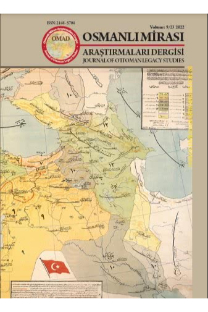THE SECRET LIFE OF CARTOONS: COGNITIVE-LINGUISTIC ANALYSIS OF THE POLITICAL CARTOONS
Karikatürlerin Gizli Hayatı: Siyasi Karikatürlerin Bilişsel-Dilsel Analizi
___
Bell, Nancy D. “How native and non-native English speakers adapt to humor in intercultural interaction.” (2007): 27-48.Berberović, Sanja, and Nihada Delibegović Džanić. “Politički humor i javni diskurs: Kognitivno-lingvistička Analiza.” OFF-SET, Tuzla (2015).
Boxer, Diana, and Florencia Cortés-Conde. “From bonding to biting: Conversational joking and identity display.” Journal of pragmatics 27, no. 3 (1997): 275-94.
Brummett, Palmira Johnson. Image and imperialism in the Ottoman revolutionary press, 1908- 1911. Suny Press, 2000.
Coulson, Seana, and Todd Oakley. “Blending basics (linguistic aspects of conceptual blending theory and conceptual integration).” Cognitive Linguistics 11, no. 3-4 (2000): 175-96.
Coulson, Seana. “What's so funny: Conceptual blending in humorous examples.” The poetics of cognition: studies of cognitive linguistics and the verbal arts (2002).
Davies, Catherine Evans. “How English-learners joke with native speakers: An interactional sociolinguistic perspective on humor as collaborative discourse across cultures.” Journal of pragmatics 35, no. 9 (2003): 1361-85.
Delibegović Džanić, Nihada, Adisa Imamović Cognitive-Linguistic Analysis of the Ottoman Empire Cartoons from English Magazines. u Osmanlı Dönemi Balkan Şehirleri 1, Gölen Z. and Temizer A. (ed.), Gece Kitapligi, (2016): 61-78.
Delibegović Džanić, Nihada, and Sanja Berberović. “Hot cakes: The use of idioms in political cartoons.” Phraseology and Culture, Bielsko-Biala, Budapest, Ka nsas, Maribor (2014): 339-53.
Delibegović Džanić, Nihada, and Sanja Berberović. “On politicians in big women’s sunglasses driving buses with their feet in mouths: Late -night political humour and conceptual integration theory.” Jezikoslovlje 11, no. 2 (2010): 197-214.
Delibegović Džanić, Nihada. “Who was born with a silver foot in his mouth? Modified idiomatic expressions in political cartoons.” Jezikoslovlje 14, no. 2-3 (2013): 323-36.
Fauconnier, Gilles, and Mark Turner. “Compression and global insight.” (2001): 283-304.
Fauconnier, Gilles, and Mark Turner. “Mental spaces: conceptual integration networks.” Cognitive linguistics: basic readings (2006): 303-71.
Fauconnier, Gilles, and Mark Turner. The way we think: Conceptual blending and the mind's hidden complexities. Basic books, 2002.
Goodenough, Ward. “Cultural Anthropology and Linguistics, Report of the Seventh Annual Round Table Meeting on Linguistics and Language Study. ” Monograph Series on Language and Linguistics 9 (1957).
Grady, Joseph, Todd Oakley, and Seana Coulson. “Blending and metaphor.” Amsterdam Studies in the Theory and History of Linguistic Science Series 4 (1999): 101-24.
Gulas, Charles S., and Marc G. Weinberger. “Humor in advertising: A comprehensive analysis.” (2006).
Hudson, Richard Anthony. Sociolinguistics. Cambridge university press, 1996.
Kovecses, Zoltan. Language, mind, and culture: A practical introduction. Oxford University Press, 2006.
Kovecses, Zoltan. Metaphor: A practical introduction. Oxford University Press, 2010.
Lewis, Paul. Comic effects: Interdisciplinary approaches to humor in literature . SUNY Press, 1989.
Marín-Arrese, Juana I. “Humour as ideological struggle: The view from cognitive linguistics.” In 8th International Cognitive Linguistics Conference. Logroño, pp. 20-25. 2003.
Palmer, Jerry. Taking humour seriously. Routledge, 1993.
Ritchie, David. “Frame-shifting in humor and irony. ” Metaphor and Symbol 20, no. 4 (2005): 275-94.
Schmid, Hans-Jörg. “Conceptual blending, relevance and novel N+ N-compounds.” In Windows to the Mind, pp. 219-246. De Gruyter Mouton, 2011.
Turner, Mark, and Gilles Fauconnier. “A mechanism of creativity.” Alternation 6, no. 2 (1999): 273-92.
Turner, Mark, and Gilles Fauconnier. “Conceptual integration and formal expression.” Metaphor and Symbol 10, no. 3 (1995): 183-204.
Turner, Mark, and Gilles Fauconnier. “Metaphor, metonymy, and binding.” In Metaphor and Metonymy at the Crossroads, pp. 133-146. De Gruyter Mouton, 2012.
Turner, Mark. The origin of ideas: Blending, creativity, and the human spark. Oxford University Press, 2014.
Varonis, Evangeline Marlos, and Susan M. Gass. “Miscommunication in native/nonnative conversation.” Language in society 14, no. 3 (1985): 327-43.
- ISSN: 2148-5704
- Yayın Aralığı: 3
- Başlangıç: 2014
- Yayıncı: Abidin Temizer
52 NUMARALI MOSTAR ŞER‘İYYE SİCİL DEFTERİNE GÖRE BOSNA’DA OSMANLI-AVUSTURYA MÜCADELESİ (1787-1789)
OSMANLI DEVRİ ORTA KARADENİZ’DE AVCI KUŞLARI (1485-1830)
ZAMANIN YÜKÜNÜ TAŞIYANLAR: YERLİ ve YABANCI SANATÇILARIN GÖZÜNDEN OSMANLI HAMALLARI
OTLUKBELİ SAVAŞI VE CASUS SEMENSA
Karikatürlerin Gizli Hayatı: Siyasi Karikatürlerin Bilişsel-Dilsel Analizi
Nihada DELIBEGOVIĆ DŽANIĆ, Sanja BERBEROVIĆ
ARŞİV BELGELERİNE GÖRE SÜLEYMANİYE CAMİİ VE KÜLLİYESİ 1858- 1859 YILLARI ONARIMI
THE SECRET LIFE OF CARTOONS: COGNITIVE-LINGUISTIC ANALYSIS OF THE POLITICAL CARTOONS
RIFKÎ’NİN KONYA ŞEHRİ İLE KESTEL VE KIZILDAĞ YAYLALARI VASFINDAKİ ŞİİRLERİ
İBB ATATÜRK KİTAPLIĞI OE 0973/3 NUMARADA KAYITLI ŞİİR MECMUASININ NAZİRELER KISMI
